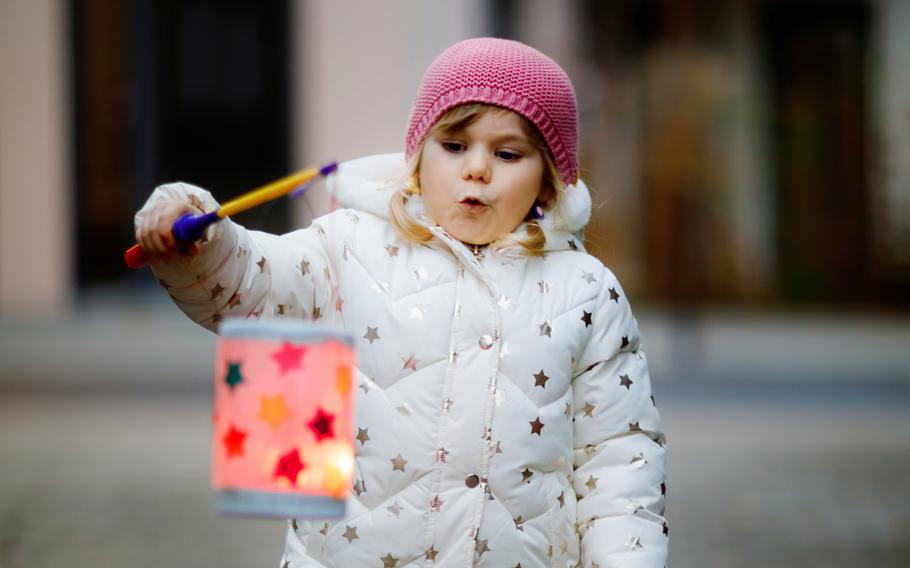
A small girl holds a homemade lantern during a St. Martin procession in Germany. Celebrations in the saint’s honor take place in Germany and elsewhere on or near Nov. 11. (iStock)
Should your parents have blessed you with the name Martin, Katharine, Luke, Nick or any one of a number of others associated with Christian saints and martyrs, lucky you! In addition to celebrating your own date of birth, you can attend a festival with your name on it and feel like the festivities are all about you. Here are just a few of the names to be celebrated across Europe in the weeks and months to come:
Martin
St. Martin is a 4th-century saint who rose to fame on the legend of how he, as a soldier in the Roman army, encountered an unclad beggar on a cold wintry night and chopped his coat in half in order to share it with him. Various celebrations in his honor, held on or around his day, take place throughout much of Europe on or close to Nov. 11. In Denmark, Mortens Aften means geese or ducks, alongside red cabbage and crispy potatoes, will be plated up in private homes and in restaurants; in Germany, eating goose, perhaps with dumplings, is the order of the day. In the Czech Republic, the goose is important, but even more so the Svatomartinské víno, the first wine of the season, which is traditionally enjoyed on the eleventh day of the eleventh month.
In Germany, particularly regions near the Rhine, communities large and small celebrate the day with parades in which primary school-age children clutch their handmade lanterns as they follow a man on horseback representing the kindly saint. The day typically ends with the distribution of gingerbread or pretzel figures. The city of Kempen in North Rhine Westphalia, some 20 miles northwest of Duesseldorf, will be celebrating the day in its usual big way, with parades of schoolchildren making their way down the city streets from 5:15 p.m. Nov. 10. Worms-Horchheim is also well-known for its parade, which is set to take place from 6 p.m. Nov. 10.
Lukas, Katharine and others
It’s the season of autumn markets throughout Germany, a tradition that had much more importance just a few scant decades ago. With the harvest in for the season and winter fast approaching, it was time to spend the wages made from helping to get the crops in with the wares needed to keep warm when the temperatures plummet. Cities’ once traditional market days have since morphed into a mashup of fun fair rides, flea or antiques markets, stands offering tasty treats, and so-called “Open Sundays,” when the usually-closed downtown retail shops are allowed to open from approximately noon to 5 p.m. Traces of the holy figures honored are reflected in the names borne by some of these events, to include:
Baden-Württemberg: Martinimarkt, Sigmaringen, with 100 market stalls, Nov. 4; Martinimarkt, Tübingen, Nov. 12-13; Nikolausmarkt, Bad Saulgau, Nov. 30.
Bavaria: Kathreinemarkt, Kempten in Allgäu, amusement rides and market stalls, Oct. 25-Nov. 3; Martinimarkt, Marktoberdorf, Nov. 2-4.
Hessen: Gallusmarkt, Grünberg, through Oct. 20; Gallusmarkt, Wetzlar, through Oct. 20; Bad Hersfeld, Lullusfest, through Oct. 21; Hofheim am Taunus, Gallusmarkt, through Oct. 22; Katharinenmarkt, Butzbach, Nov. 2-4; Herborn, Martinimarkt, Nov. 8-11; Martinimarkt, Bad Schwalbach, Nov. 8-12.
Rheinland-Pfalz: Lukasmarkt, Mayen, through Oct. 20; Katharinenmarkt, Oppenheim, Oct. 19-20; Martinimarkt, Alzey, includes a French farmer’s market, Oct. 20; Katharinenmarkt, Hachenburg in Westerwald, Nov. 2.
Nicholas
So beloved is St. Nicholas that the people of Bari, Italy, celebrate their patron saint twice: once in May, in memory of the arrival of the saint’s relics by ship back in the year 1087, and once again on Dec. 6. The winter date is a day of pilgrimage, attracting the faithful to meet in the Basilica of San Nicola, watch a historical procession, and end the day with the lighting of a large Christmas tree. Celebrations actually kick off on the eve of the day, when the Basilica opens its doors for the celebration of the day’s first Holy Mass, and the alleys of the old town fill with the sweet scent of hot chocolate, a type of fried polenta known as sgagliozze and other seasonal treats. Online: tinyurl.com/yc2hmv44
As the patron saint of merchants, sailors and guilds, it’s not so surprising that the city of Amsterdam also adopted Nicholas as their protector. Looking after the Netherlands’ capital since the 14th century, the man known locally as Sinterklaas will make his annual grand entry to the city on Nov. 17. Sinterklaas starts his journey at 10 a.m. with a steamboat ride along the Amstel River and docks near the Maritime Museum at 11:45 a.m. Following his reception by the mayor, he will proceed to the Waterlooplein, where he will mount his white horse Amerigo and begin his ride through town, passing over Rembrandtplein and Frederiksplein before arriving at the Leidseplein shortly before 3 p.m., at which time he will deliver a speech from the balcony of the Stadsschouwburg city theater. Online: sintinamsterdam.nl
Lucia
According to legend, Lucia was a young woman from the city of Syracuse on the island of Sicily. An early Christian from a wealthy family, she gave up her dowry to the poor, an act that enraged her suitor. Put on trial and condemned to death for being a witch, she was to be burned at the stake. When the fire refused to light, her tormentors stabbed her in the neck instead. Syracuse remembers its young martyr with the Festa di Santa Lucia held annually on Dec. 13. A silver statue of the patron saint is the centerpiece of a vast procession that makes its way from the Cathedral to the Church of St. Lucia. On Dec. 20, the statue is paraded in the opposite direction, with fireworks set off above the Umbertino Bridge before the statue’s ultimate return to the Cathedral. Online: tinyurl.com/4dth87ce